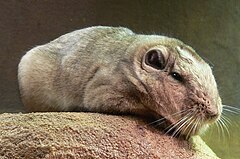Porcupine relatives
| Porcupine relatives | ||||||||||||
|---|---|---|---|---|---|---|---|---|---|---|---|---|

Common porcupine ( Hystrix cristata ) |
||||||||||||
| Systematics | ||||||||||||
|
||||||||||||
| Scientific name | ||||||||||||
| Hystricomorpha | ||||||||||||
| Brandt , 1855 |

The porcupine relatives (Hystricomorpha, partly also Ctenohystrica) are a subordination of the rodents (Rodentia).
General
The morphological criteria for this subordination are largely based on the structure of the lower jaw and the skull, especially the zygomatic bone . A further differentiation was made through molecular genetic studies, so that the thorntail squirrel relatives , which in the past were sometimes also included, are now classified as a separate suborder.
This subordination includes almost 300 species, most of which are common on the American continent .
Systematics
- Family incertae sedis : Laotian rock rat (Diatomyidae)
-
Comb finger-like (Ctenodactylomorphi or Sciuravida)
- Comb fingers or gundis (Ctenodactylidae)
- Partial order hystricognathi
- Porcupines (Hystricidae)
-
Phiomorpha
- Sand graves (Bathyergidae)
- Naked mole rat (Heterocephalidae)
- Rock rat (Petromuridae)
- Reed rats (Thryonomyidae)
-
Guinea Pig Relatives (Caviomorpha)
- Tree prick (Erethizontidae)
- Chinchillas (Chinchillidae)
- Pakarana (Dinomyidae)
- Guinea pigs (Caviidae)
- Agoutis and Acouchis (Dasyproctidae)
- Pakas (Cuniculidae)
- Comb rats (Ctenomyidae)
- Trug rats (Octodontidae)
- Chinchilla rats (Abrocomidae)
- Quill rats (Echimyidae)
- Beaver rat (Myocastoridae)
- Tree rats (Capromyidae)
- Giant hatias (Heptaxodontidae) †
The following cladogram shows the possible relationships
| Hystricomorpha |
|
||||||||||||||||||||||||||||||||||||
|
|
literature
- Michael D. Carleton, Guy G. Musser: Order Rodentia. In: Don E. Wilson , DeeAnn M. Reeder (Eds.): Mammal Species of the World. A taxonomic and geographic Reference. 2 volumes. 3. Edition. Johns Hopkins University Press, Baltimore MD 2005, ISBN 0-8018-8221-4 , pp. 745-1600.
Individual evidence
- ↑ Pierre-Henri Fabre, Lionel Hautier, Dimitar Dimitrov, Emmanuel JP Douzery (2012): A glimpse on the pattern of rodent diversification: a phylogenetic approach. BMC Evolutionary Biology 2012, 12:88 PM ( online open access)
- ↑ Heritage S. et al. 2016. Ancient phylogenetic divergence of the enigmatic African rodent Zenkerella and the origin of anomalurid gliding. PeerJ 4: e2320; doi: 10.7717 / peerj.2320